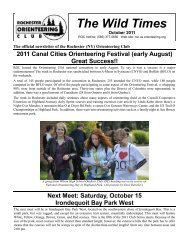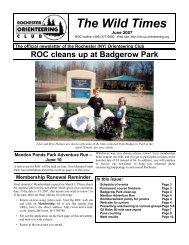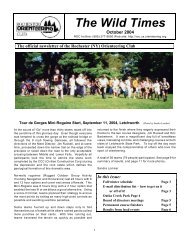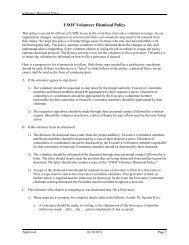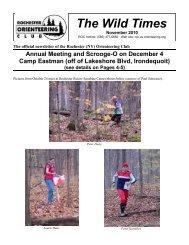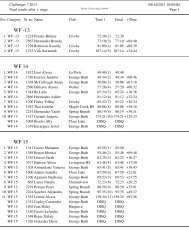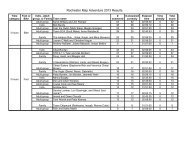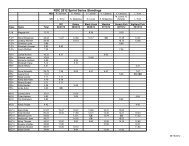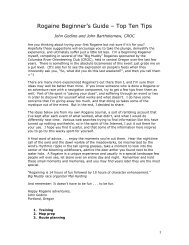A Rules for Foot Orienteering Events - Orienteering USA
A Rules for Foot Orienteering Events - Orienteering USA
A Rules for Foot Orienteering Events - Orienteering USA
Create successful ePaper yourself
Turn your PDF publications into a flip-book with our unique Google optimized e-Paper software.
B.14 Courses<br />
B.14.1 A Rogaine is traditionally 24-hour duration. For other events, shorter or<br />
potentially longer durations would be acceptable. It is common in the U.S. to<br />
concurrently run two or more different duration events on the same course.<br />
B.14.2 The U.S. Rogaine Championships shall be of the traditional 24-hour duration.<br />
B.14.3 It is usual to have approximately 50 to 60 control locations <strong>for</strong> a 24- hour rogaine.<br />
Explanations <strong>for</strong> substantially larger or smaller numbers of controls should<br />
accompany a sanctioning request.<br />
B.14.4 It is worthwhile to review the rather detailed suggestions <strong>for</strong> organizing a Rogaine<br />
on the International Rogaining Federation web site http://www.rogaining.com/<br />
B.15 Control Set-up<br />
B.15.1 <strong>Orienteering</strong> control markers are normally used to mark checkpoints. These must<br />
be supplemented with a sign-in sheet at which all teams must indicate their arrival<br />
time and intended next checkpoint as in accord with .<br />
B.15.2 In addition, it is usual in the U.S. to provide some <strong>for</strong>m of reflective marking at<br />
night (often a small PVC tube wrapped with reflective tape hung on the string <strong>for</strong><br />
suspending the control flag, or small patches of reflective tape on the faces of the<br />
control markers), so that the range of visibility of the control flag is extended to a<br />
level similar to the daytime situation. This may not be necessary in lowvegetation<br />
parts of the country.<br />
B.15.3 Markers are to be hung at eye level if possible, with visibility both day and night<br />
in most directions of possible approach.<br />
B.15.4 A Control Flag shall mark each control location. The control flag consists of<br />
three squares arranged in triangular <strong>for</strong>m. Each square is a 30cm X 30cm and is<br />
divided diagonally, one half being white and the other half orange (ideally PMS<br />
165). At least two of the white triangles shall be adjacent to the upper edge of the<br />
control flag. (Additional color of blue stripe 2.54 to 5.08 cm wide, centered,<br />
vertically or along the diagonal divide is allowed)<br />
B.15.5 Every control flag shall have a code card and marking device/s associated with it.<br />
The relative arrangement of the control flag, control code, and marking devices<br />
shall be the same <strong>for</strong> all the control locations on a course.<br />
B.15.6 The control flag shall be hung at the feature indicated on the map.<br />
B.15.7 A Control Code shall identify each control location. The same code shall be<br />
included on the map. The figures shall be black; approximately 6-10cm high with<br />
a line width of approximately 6-10mm. Ideally the competitor will only be able to<br />
read the codes when immediately at the control flag.<br />
B.15.8 There shall not be other confusing figures or marks on the control flag.



